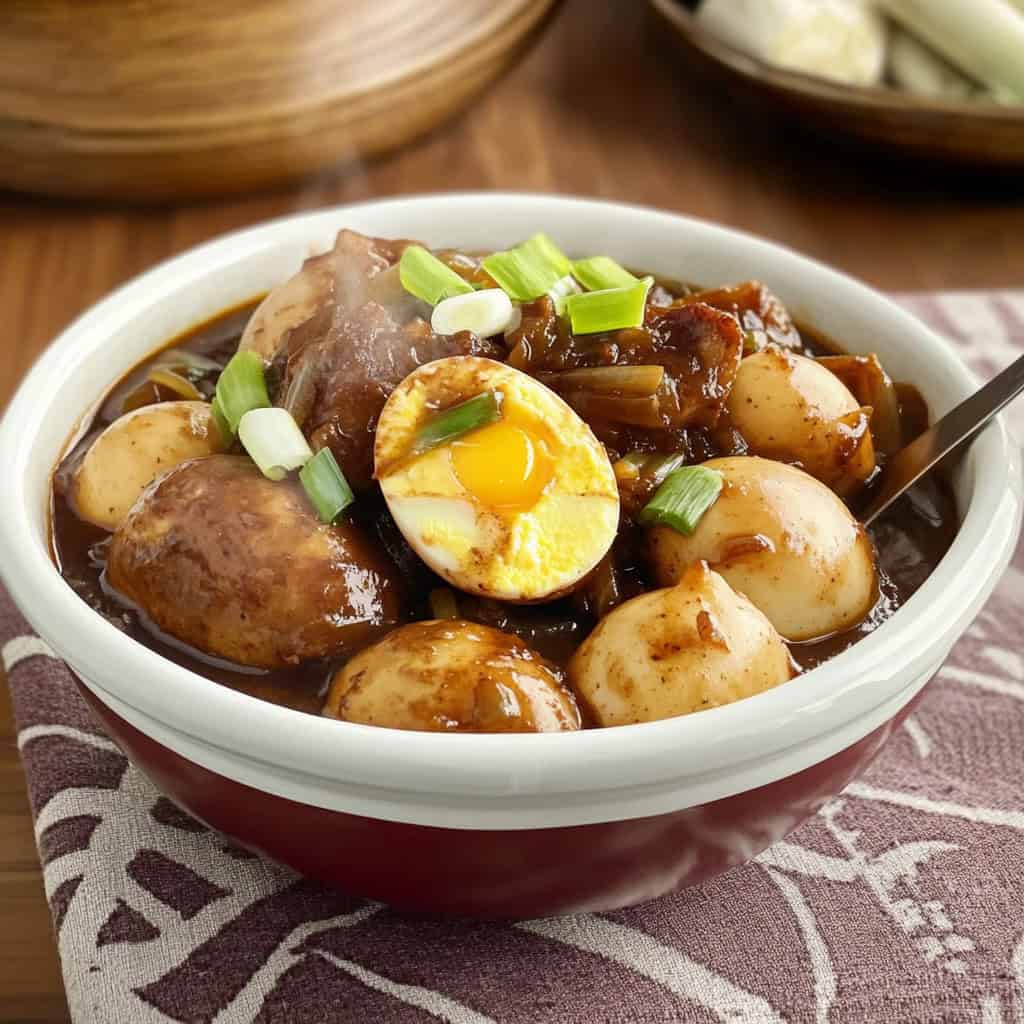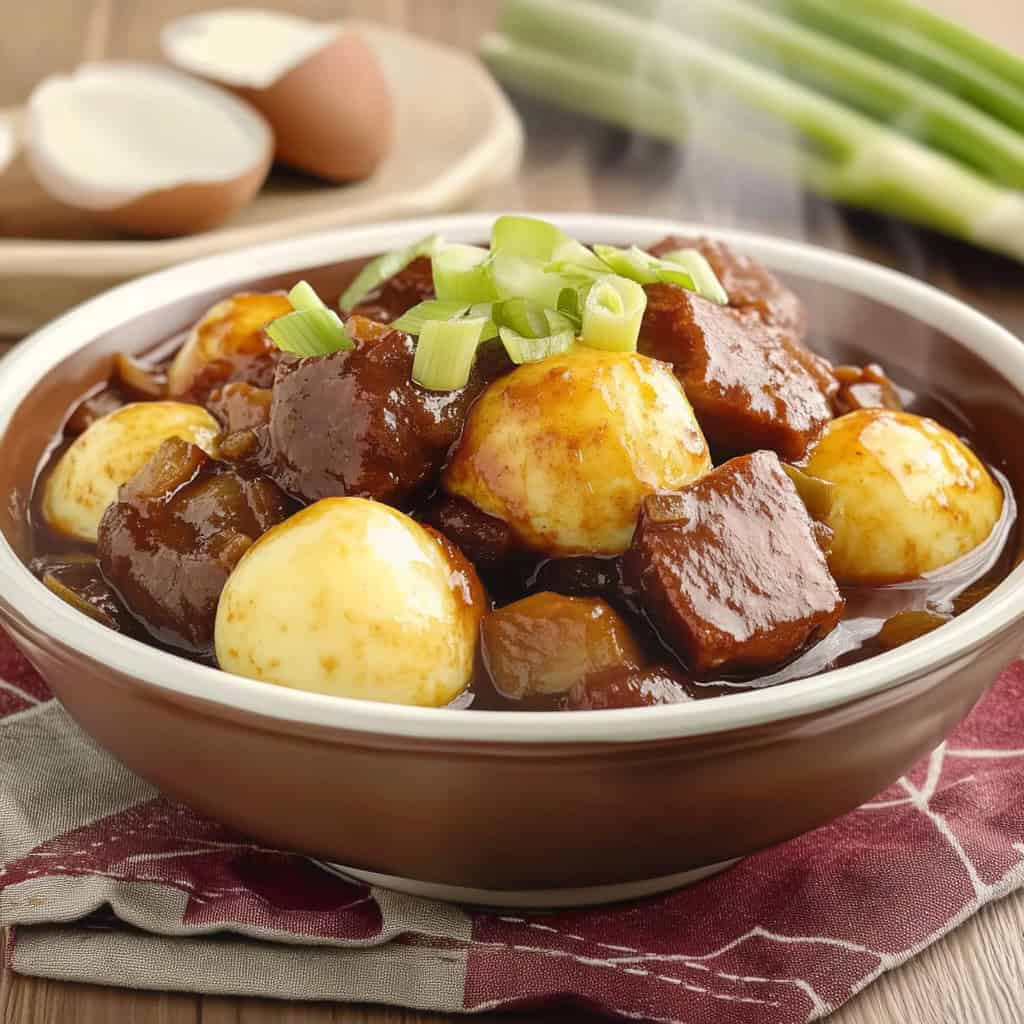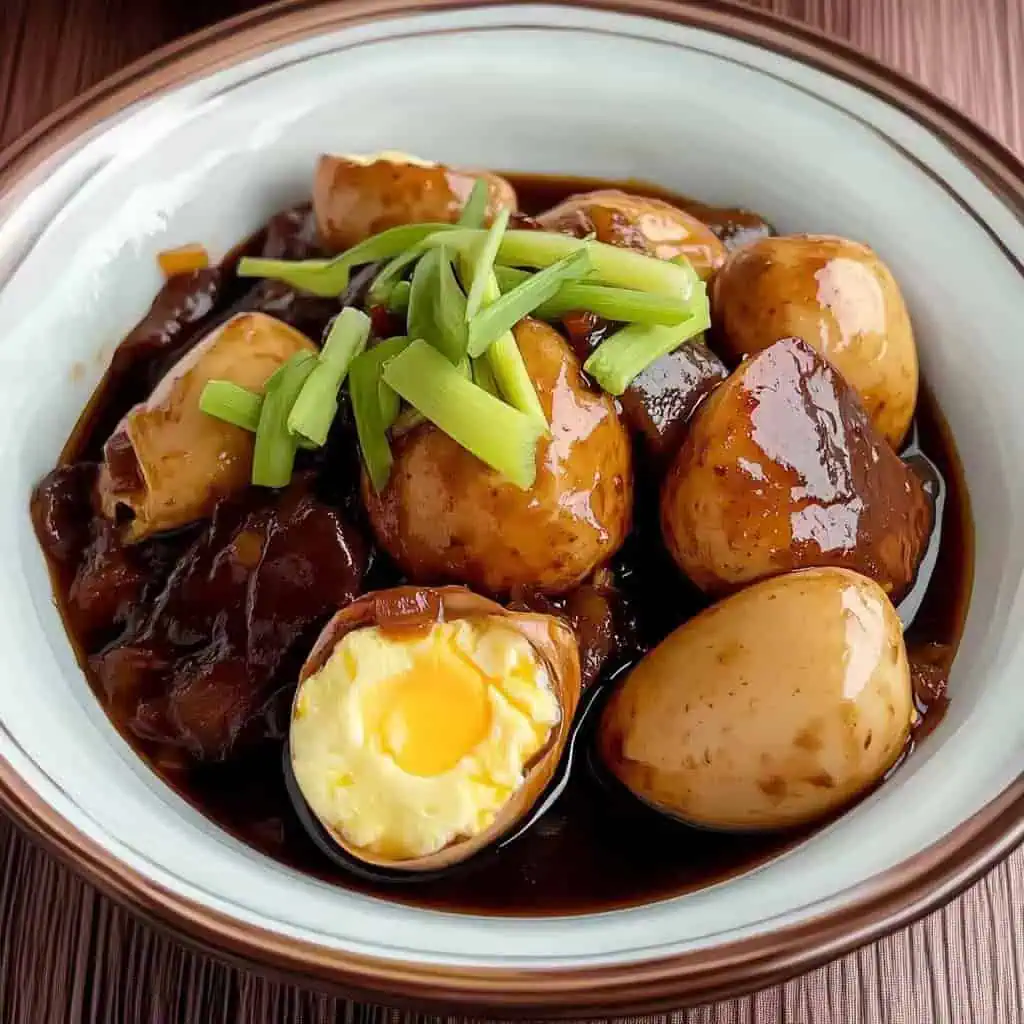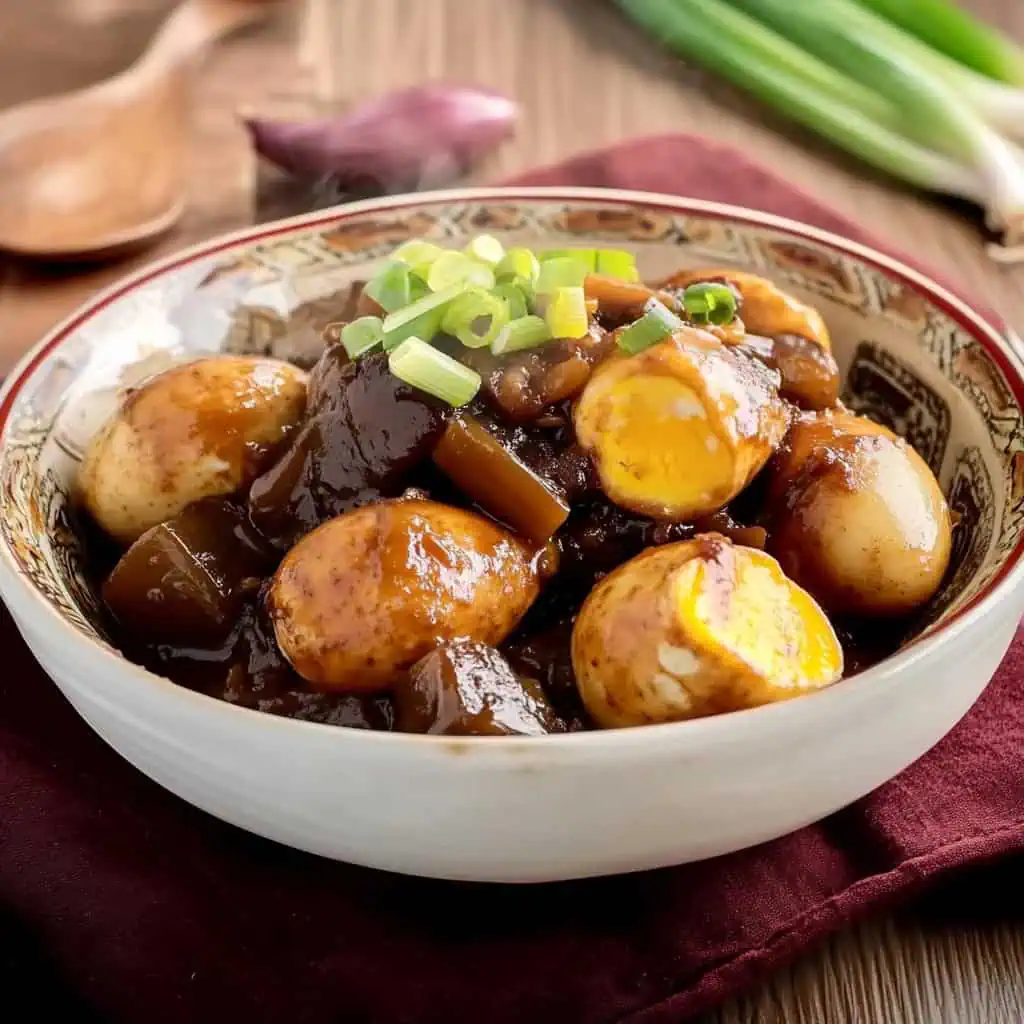Let me share my absolute favorite way to enjoy adobo when the budget is tight but the craving is real. This Adobong Itlog has saved me countless times when payday feels too far away, but I still want those rich, comforting adobo flavors. It's my go-to "tipid" (budget-friendly) version that transforms simple hard-boiled eggs into something truly special.
Don't let its simplicity fool you. Once those eggs soak up the savory-tangy sauce, you'll understand why this humble dish is a staple in my kitchen. I learned this from my Lola, who always said "Kahit simple ang ingredients, pwedeng maging masarap kung tama ang pagluluto" (Even simple ingredients can be delicious when cooked right).
You probably have everything you need in your pantry right now. Let me show you how to make this wallet-friendly adobo that never fails to satisfy that Filipino comfort food craving.
Jump to:

Why You'll Love This Recipe
- Quick & Easy: Ready in just 40 minutes from start to finish
- Budget-Friendly: Uses simple, affordable ingredients you likely have at home
- Versatile: Perfect for breakfast, lunch, or dinner
- Meal Prep Friendly: Keeps well in the refrigerator for days
- No Waste: Great way to use up extra eggs
- Rich in Protein: Excellent source of affordable protein
- Family Favorite: A comforting dish that appeals to all ages
Ingredients
The heart of any adobo is the perfect balance of vinegar (for tanginess), soy sauce (for umami), and garlic (for aromatic depth). Potatoes add hearty substance and absorb the flavorful sauce, while eggs provide affordable protein that soaks up all those delicious flavors.
Bay leaves and peppercorns contribute subtle aromatic notes that round out the dish without overpowering it. This combination creates a satisfying, budget-friendly meal with authentic Filipino flavors using ingredients most people already have in their pantry.

For the Hard-Boiled Eggs:
- 6 large eggs (preferably 1-2 weeks old for easier peeling)
- Water for boiling
- Ice for ice bath
For the Adobo Sauce:
- ¼ cup canola oil
- 2 medium potatoes, peeled and cubed (about 1-inch pieces)
- 1 small onion, finely chopped
- 5 cloves garlic, minced
- ¼ cup white vinegar
- ¼ cup soy sauce
- ¼ cup water
- 2 bay leaves
- 1 teaspoon whole black peppercorns
- Salt to taste
- ½ teaspoon sugar (optional, balances acidity)
Equipment
- Large Saucepan - For boiling eggs. A medium-sized pot with enough depth to fully submerge eggs in water ensures even cooking.
- Heavy-Bottom Skillet or Wok - The thick base provides even heat distribution for properly browning potatoes and developing flavors in the sauce without burning.
- Sharp Knife and Cutting Board - For precise cutting of potatoes and onions to ensure uniform cooking.
- Measuring Cups and Spoons - For accurate ingredient proportions that maintain the perfect balance of sour, savory, and salty flavors.
- Wooden Spoon - Better than metal utensils for this dish as it won't react with the acidic ingredients and won't scratch your cookware.
- Spider Strainer or Slotted Spoon - Essential for removing eggs from boiling water without cracking them.
- Timer - Crucial for achieving perfectly cooked hard-boiled eggs with tender whites and fully set (but not overcooked) yolks.
- Small Bowl - For preparing an ice bath to shock the boiled eggs and stop the cooking process.

How To Make
- Prepare the eggs: Place eggs in a pot and cover with cold water by 1 inch. Bring to a boil over medium-high heat. Once boiling, turn off heat, cover, and let stand for exactly 10 minutes. Transfer eggs to an ice bath and let cool for 5 minutes before peeling carefully.
- Fry the potatoes: Heat oil in a large pan over medium heat. Add cubed potatoes and fry until golden brown on all sides, about 5-7 minutes. Remove potatoes using a slotted spoon and set aside, leaving about 2 tablespoons of oil in the pan.
- Create the flavor base: In the same pan with remaining oil, sauté minced garlic until light golden and fragrant, about 1 minute. Add chopped onions and cook until translucent and soft, about 3-4 minutes.
- Build the adobo sauce: Pour in the vinegar and let it boil without stirring for 3-5 minutes – this crucial step allows the acidity to mellow. Add soy sauce, water, bay leaves, and whole peppercorns. Let simmer for 5 minutes to marry the flavors.
- Combine everything: Gently place your peeled hard-boiled eggs into the sauce. Return the fried potatoes to the pan. Cover and simmer on low heat for 15 minutes, occasionally spooning the sauce over the eggs. The sauce should reduce slightly and the potatoes should become fork-tender.
- Finish the dish: Taste the sauce and adjust with salt if needed (this will depend on your soy sauce's saltiness). If too tangy, add the optional sugar. Remove bay leaves before serving.
- Rest and serve: Let the dish rest for 5 minutes off heat so the eggs can absorb more sauce. Serve hot over steamed white rice, spooning extra sauce over the top.

Tips from Lola's Kitchen
- For perfectly peelable eggs: Use eggs that have been in your refrigerator for 7-10 days. The slight air pocket that develops makes them significantly easier to peel.
- The key to flavor development: Never stir the vinegar while it's reducing. This crucial step allows the harsh acidity to mellow while concentrating flavor.
- For flavor-soaked potatoes: Before adding potato cubes to the sauce, pierce them several times with a fork. These tiny channels help them absorb more of the delicious adobo sauce.
- For extra depth: Toast the garlic until golden brown (not burnt) for a nuttier, more complex flavor profile that enhances the entire dish.
- The ultimate finish: A splash of calamansi juice (or lemon in a pinch) added just before serving brightens all the flavors and adds a fresh dimension.
- Patience pays off: Allow the eggs to simmer in the sauce longer for a more flavorful result. The longer they sit, even overnight in the refrigerator, the more intensely flavored they become.
- Rice preparation tip: Start your rice cooking when you begin simmering the eggs and potatoes. Both will be ready at the same time for the perfect meal.
- Layer your bowl properly: Place rice first, then potatoes, then halved eggs with the yolks facing up, and finally pour sauce over everything for the most visually appealing and delicious serving method.
Substitutions
- Canola oil → Coconut oil for a subtle tropical flavor that pairs beautifully with the adobo profile, or any neutral vegetable oil you have on hand.
- White vinegar → Apple cider vinegar for a slightly fruitier profile, or traditional Filipino cane vinegar (sukang maasim) for authentic flavor.
- Soy sauce → Liquid aminos or coconut aminos for a gluten-free alternative with slightly different but complementary flavor profiles.
- Potatoes → Sweet potatoes for added nutritional value and subtle sweetness, or taro root for an even more traditional Filipino twist.
- White onion → Red onion or shallots for a milder, slightly sweeter flavor base.
- Bay leaves → Lemongrass stalks (bruised) for a Southeast Asian flavor variation.
- Black peppercorns → Green peppercorns for a fresher, less pungent heat.
Troubleshooting
- Sauce too sour? Add ½ teaspoon sugar at a time or a bit more soy sauce to balance acidity. A small splash of coconut milk can also temper excessive tanginess.
- Eggs cracking during cooking? Start with room temperature eggs and place them in cold (not boiling) water before heating gradually.
- Potatoes falling apart? Make sure to brown them well before adding to the sauce – this creates a firmer exterior that helps maintain their shape.
- Sauce too thin? Simmer uncovered for the last 5-7 minutes to reduce and concentrate the flavors.
- Eggs difficult to peel? Use older eggs (not fresh) and peel them under gently running cool water to help separate the membrane from the white.
- Sauce too salty? Add a peeled, quartered potato to the sauce while simmering – it will absorb some of the salt. Remove before serving.
- Eggs turning grayish around the yolk? This indicates overcooking. Follow the exact timing for perfect eggs every time.
Storage & Reheating
- Refrigeration: Store in an airtight container for up to 3 days. The flavor actually improves overnight as the eggs continue to absorb the sauce.
- Do not freeze as this affects egg texture significantly, making them rubbery and unpleasant.
- For best reheating results: Bring to room temperature for 15 minutes, then gently warm in a covered pan over medium-low heat, adding a tablespoon of water if the sauce has thickened too much.
- To refresh the dish when reheating: Add a small splash of vinegar and a fresh clove of minced garlic to revitalize the flavors.
- Meal prep tip: Prepare a double batch of the sauce separately and freeze in portions. When needed, thaw and simmer with freshly boiled eggs for a quick meal.

FAQ
Can I make this ahead of time?
Absolutely! Adobong Itlog actually tastes better after sitting overnight as the eggs continue to absorb flavor. Make it up to 2 days ahead for optimal taste.
Why should I fry the potatoes first instead of just simmering them?
Frying creates a caramelized exterior that adds depth of flavor and helps the potatoes maintain their shape during simmering instead of falling apart.
Is this dish keto-friendly?
Without the potatoes, this dish becomes keto-compatible. You can substitute cauliflower florets for potatoes to maintain the hearty texture while keeping carbs low.
Can I add meat to this recipe?
Yes! Add 1 cup of diced chicken thighs or pork belly when sautéing the onions and garlic for a more protein-rich variation.
What's the best vinegar to use for authentic flavor?
Cane vinegar (sukang maasim) is traditional in Filipino cooking and gives the most authentic flavor, but white vinegar works perfectly well for this recipe.
Why do my eggs sometimes turn rubbery?
Overcooking either during the initial boiling or during the simmering in sauce can cause rubbery eggs. Follow the timing precisely and keep the simmer gentle.
Can I add vegetables to make this a complete one-pot meal?
Absolutely! Bell peppers, green beans, or bok choy added during the last 5 minutes of cooking work beautifully with the adobo flavors.
What's the difference between this and regular chicken or pork adobo?
The cooking technique and sauce are identical, but eggs absorb flavors differently than meat. The result is a milder dish that showcases the pure essence of adobo flavors.
How can I make this spicy?
Add 1-2 Thai bird chilies (whole or sliced) or 1 teaspoon of chili garlic sauce to the simmering sauce for a pleasant heat that complements the tangy profile.
Can I use soft-boiled eggs instead of hard-boiled?
While traditional Adobong Itlog uses hard-boiled eggs, using eggs boiled for just 7 minutes creates a delicious variation with jammy yolks that blend wonderfully with the sauce when broken.
Related
Looking for other recipes like this? Try these:

Adobong Itlog (Filipino Egg Adobo)
Equipment
- Large saucepan (For boiling eggs) - Kaldero
- Heavy-bottom skillet or wok (For cooking adobo) - Kawali
- Sharp knife and cutting board (kutsilyo at sangkalan)
- Measuring cups and spoons (Panukat)
- Wooden Spoon (Sandok Kahoy)
- Spider strainer or slotted spoon - Siyanse
- Timer (for perfect eggs)
Ingredients
For the Hard-Boiled Eggs:
- 6 large eggs - Itlog
- Water for boiling - Tubig
For the Adobo Sauce:
- ¼ cup canola oil - Langis
- 2 medium potatoes peeled and cubed - Patatas
- 1 small onion finely chopped - Sibuyas
- 5 cloves garlic minced - Bawang
- ¼ cup white vinegar - Suka
- ¼ cup soy sauce - Toyo
- ¼ cup water - Tubig
- 2 bay leaves optional - Dahon ng laurel
- 1 teaspoon whole black peppercorns - Paminta
- Salt to taste - Asin
Instructions
- Start by hard-boiling your eggs: place them in a pot and cover with cold water. Bring to a boil, then turn off heat, cover, and let stand for 10 minutes. Transfer eggs to an ice bath, then peel them carefully.
- Heat oil in a large pan over medium heat. Add your cubed potatoes and fry until golden brown on all sides, about 5-7 minutes. Remove potatoes and set aside.
- In the same pan with about 2 tablespoons of oil remaining, cook minced garlic until light golden and fragrant. Add chopped onions and cook until they turn clear and soft, about 3-4 minutes.
- Pour in the vinegar and let it boil without stirring for 3-5 minutes – this step is important for the flavor. Add soy sauce, water, bay leaves, and whole peppercorns. Let it simmer for 5 minutes to combine the flavors.
- Gently place your peeled hard-boiled eggs into the sauce. Add back the fried potatoes. Cover the pan and simmer on low heat for 15-20 minutes, occasionally spooning the sauce over the eggs. The sauce will thicken and the potatoes should become tender.
- Taste the sauce and add salt if needed. Remove bay leaves before serving. Let it rest for 5 minutes so the eggs can soak up more sauce. Serve hot over steamed rice.
- For the best flavor, make sure the eggs and potatoes spend enough time simmering in the sauce – this helps them absorb all those delicious adobo flavors. The sauce should be tangy, savory, and slightly thick when done.
Tips from Lola's Kitchen
- Age your eggs for 1-2 weeks before boiling for easier peeling
- Never stir the vinegar while it's reducing to achieve the best flavor
- Pierce potato cubes with a fork before adding to the sauce to help them absorb more flavor
- Add a splash of calamansi juice at the end for extra tang
- Toast garlic until golden for a nuttier flavor profile
Nutrition
The Story Behind Adobong Itlog
In the heart of Filipino home cooking lies a testament to resourcefulness and culinary ingenuity - Adobong Itlog, a budget-conscious adaptation of the Philippines' beloved national dish. While the origins of adobo trace back to the pre-colonial era, when vinegar and salt were used to preserve meat in the tropical climate, this egg-based variation emerged during more challenging economic times, demonstrating the Filipino spirit of making the most of available ingredients.
Traditionally, eggs were added to meat-based adobo dishes to extend the protein content, making the dish more filling for large families. However, as households adapted to varying economic circumstances, particularly during the post-war period of the 1950s, creative home cooks began preparing adobo using eggs as the primary protein. This innovation proved that the signature adobo cooking technique - the harmonious blend of vinegar, soy sauce, and aromatics - could transform even the most humble ingredients into a satisfying meal.
The addition of potatoes to Adobong Itlog further exemplifies the dish's evolution as a practical yet delicious solution for feeding families on a budget. These starchy cubes not only help stretch the dish further but also serve as excellent vessels for soaking up the rich, tangy sauce that defines the adobo flavor profile. This combination of eggs and potatoes in adobo sauce has become so beloved that it's now considered a comfort food in its own right, rather than merely a thrifty alternative to meat-based versions.
Today, Adobong Itlog holds a special place in Filipino cuisine, particularly among students, young professionals, and families looking for economical yet satisfying meals. Its enduring popularity speaks to both its delicious taste and its role in Philippine culinary heritage, where necessity often breeds creativity in the kitchen. Many Filipino food historians now recognize this dish as a prime example of how economic constraints can lead to culinary innovations that become cherished traditions in their own right.
What makes this dish particularly special is its accessibility - requiring just a few basic pantry staples, it demonstrates how the distinctive adobo cooking method can elevate simple ingredients into a memorable meal. Whether served for breakfast with garlic rice (sinangag) or as a hearty dinner, Adobong Itlog continues to prove that some of the most beloved dishes come from humble beginnings and creative cooking techniques passed down through generations of Filipino families.










Comments
No Comments